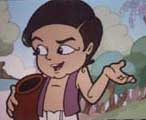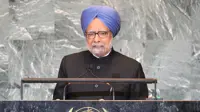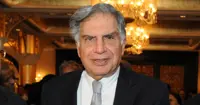Toon to tango
By Probir Roy | 05 Dec 2003
 Mumbai:
Animation has come a long, long way since the first
public screening of animation with cinematic apparatus
that used hand-painted sequences on celluloid strips.
Today the global market is worth about $50 billion and
is projected to become a $70-billion industry by 2007.
Mumbai:
Animation has come a long, long way since the first
public screening of animation with cinematic apparatus
that used hand-painted sequences on celluloid strips.
Today the global market is worth about $50 billion and
is projected to become a $70-billion industry by 2007.
Though global figures looks quite impressive, the share of the Indian animation market is a mere $0.6 billion, with just $20 million in export. It may be growing year on year, but is not going anywhere. The Indian animation sector is, at best, at the crossroads, while its better-off cousins — IT and business-process outsourcing services — are consolidating their scale, reach and focus, and continue to create ripples in the global market.
The industry is beset with problems of size and scale, lack of global presence and marketing muscle, low margins, time and quality issues, low level of supply of quality animators, low entry barriers, and poor domestic demand to give the much-needed boost for such a fledgling market. Several companies of late have shut shop overnight, merged with parent/larger companies or scaled down, and most stuck in the sub-$1-million scale, even after a decade of being around.
So while the world ''outsources'' more or less everything to India, has animation missed the bus? Clearly there are two types of companies today — the first category catering to the typical back-end ''outsourcing'', and the second having core competencies in original storytelling and indigenous character development for local market fare and co-productions.
The former is by and large denominated by low-end or relatively low-value work catering to 2D animation. On an average it costs about $30,000-75,000 for an average episode produced in India as compared to $100,000-150,000 or so in the Philippines, Taiwan or Japan. A standard 22/24-minute episode if made in India costs 70% less compared to the production costs in the US; Disney, Sony, DreamWorks, Warner Bros and Pixar being some international firms that are quietly reaping the benefits of this cost-advantage.
India does remain a preferred destination in spite of very strong competition from Taiwan, the Philippines, Japan, South Korea and Mainland China. This despite the fact that these countries have been servicing the outsourcing needs of the West for over three decades, while Indian companies only entered the fray in the mid-90s.
 The
Indian animation segment traditionally owes a lot to
the advertising and TV fraternity where TV commercials
and brands accepted character illustrations like The
Amul Girl, Gattoo (the Asian Paints mascot), The
Handiplast Boy, The Bata Bubble Gumme, 30-second
''animercials'' for brands like Hutch, Amaron, Orange,
All-Out Mosquito Repellent, 7-Up, Kellogg''s, ICICI,
Morten, Good-Night and Vicks. This proves
that animation is now an acceptable medium to convey
brand properties and values.
The
Indian animation segment traditionally owes a lot to
the advertising and TV fraternity where TV commercials
and brands accepted character illustrations like The
Amul Girl, Gattoo (the Asian Paints mascot), The
Handiplast Boy, The Bata Bubble Gumme, 30-second
''animercials'' for brands like Hutch, Amaron, Orange,
All-Out Mosquito Repellent, 7-Up, Kellogg''s, ICICI,
Morten, Good-Night and Vicks. This proves
that animation is now an acceptable medium to convey
brand properties and values.
The various mythological films and serials also spun off cartoon forms to educate the masses and complement efforts of organisations like UNESCO, UNICEF, Doordarshan and the ministry of health and family welfare to address social issues using the more benign cartoon and animation format to deliver a social message.
Unfortunately the same agency fraternity has not been able to grow the market mainly because animation for them is still seen as a distinct post-production and visual effects process rather than as an integral component of the master production process, thereby making it prone to severe budget restrictions and low attention value. Ironically animation companies depend on these ''sponsors'' to give them steady work while at the same time make them prone to being squeezed for margins and back-breaking work in tough times.
The plethora of interest groups like TASI, APAI, ASIFA-India and Nasscom, and concomitant duplication of efforts and a disjointed national image that is conveyed are not helping either. In the 2002 Annecy Festival in France, the Oscar and in Cannes, the South Koreans had organised their animation studios under one umbrella and stall.
 The
studios were competitors to each other in their home
country (like in India) but projected Korea as a major
outsourcing hub (unlike in India). This ensured that
Korea as a country had a better chance of grabbing business
than any other individual entity working in isolation.
The
studios were competitors to each other in their home
country (like in India) but projected Korea as a major
outsourcing hub (unlike in India). This ensured that
Korea as a country had a better chance of grabbing business
than any other individual entity working in isolation.
The
nascent Indian animation market must find ways to move
up the value chain and get out of the current mindset
by adopting a three-pronged strategy:
1. Original character development and storylines for
the significant domestic and cross-cultural audiences
2. Moving on to 3D/digital graphics, flash-and-live
action animation and taking on the resultant high-end
outsourcing work available from US studios as they themselves
quite clearly look to pare costs. This can be made possible
by a distributed workflow model, which in turn has been
made possible by common hardware, database systems,
tools and off-the-shelf software suite, enabling artists
scattered across the world to send in scene files and
have them rendered into finished frames centrally.
3. International co-production, whilst an emerging option
for sharing risks and resources, is not a particularly
new idea. It is in an experimental stage even for the
mature Indian film industry. What co-production and
owning intellectual property rights does to companies
is to leverage alternative revenue streams and footprints
that come with the turf — terrestrial, video/CD
releases, print, merchandising, licensing, first-run
cable and theatrical rights. This will provide the necessary
commercial environment for development of character,
experimentation and even co-production.
It is in these areas that tomorrow''s opportunities lie and where India can become the ''most preferred'' offshore facility for such type of high-end/high value work. These strategies quite clearly will put them on a path of achieving a critical mass that has eluded them so far — something which just 2D outsourcing will never be able to put it in the big league. There are companies in India that can ramp up and manage from 10 to 100 people in a month and to 1,000 in six months for the right kind and size of a project, but, alas, such projects continue to be the exception rather than the rule.
Today, somehow, several TV channels have stepped in and provided the much-needed fillip to the struggling industry by running local animation fare. Even global and domestic brands like Asianet, ESPN-Star, Sony Max, Discovery, Nickelodeon and TNT Cartoon Channel have found ready acceptance of local animation fare among their respective target audiences (Tenali Ram, Hanuman, Pandava).
 Turner
International''s Cartoon Channel is currently telecasting
episodes of Adventures of Chota Birbal while
a mainstream entertainment channel has commissioned
Bheema Kheema, India''s first 52-episode series
for children to be aired from mid-February 2004.
Turner
International''s Cartoon Channel is currently telecasting
episodes of Adventures of Chota Birbal while
a mainstream entertainment channel has commissioned
Bheema Kheema, India''s first 52-episode series
for children to be aired from mid-February 2004.
In the US, the biggest market in the world, a recent partnership between IT giant IBM and independent producers for CG feature film production, economics of scale and size and workstation technology will radically alter the dynamics of the animation market yet again. And it is true that mega-size projects ($60 million-plus) and revenues determine who does what work where.
It
is no secret that Pixar''s (one of the few independent
computer-animation companies) five animated full-length
feature films have earned it more than $2 billion from
worldwide box office. And sample this. The ''hit'' of
tomorrow (Foodfight, produced by Larry Kasanoff,
TDRL, involving 138 speaking ''main'' characters, 6,254
''secondary'' characters, 174 sets that include 5,000
''buildings'' and 12,000 lights) was ''filmed'' in the garages
of Santa Monica and in the by-lanes of Taipei and Mumbai
(and not in the backlots of Shanghai and Hollywood)
at half the cost of a typical Pixar full-length CG feature
film.
Latest articles
Featured articles

Hariman Sharma lets apple travel to India’s warmer climes
10 Feb 2025
Apple, which was the preserve of the cooler Himalayan region in India, is now everywhere – in the East, the West and the South - thanks to one enterprising Himachal farmer, Hariman Sharma.

The cost of neglecting water transport
03 Feb 2025
Inland water transport is widely recognised as a cheaper and environment friendly mode of transport and, as per a report prepared by RITES

Crypto Currencies Trying To Undermine Global Financial System
27 Jan 2025
US President Donald Trump, it seems, is the latest to join the frenzy for personal or corporate currency, with $TRUMP, or what they call a meme coin, giving a further boost to his crypto image.

As costs of saying final goodbyes rise UK families resort to crowdfunding to pay for funerals
By Axel Miller | 16 Jan 2025
The cost of saying a final goodbye to loved ones in the UK has reached a grim new high, leaving families grappling with unexpected financial burdens.

The life and times of Manmohan Singh, former Prime Minister of India
By Cygnus | 28 Dec 2024
On 27th December 2024 India and the world lost one of their finest statespersons in a hundred years. Manmohan Singh, born on 26th September 1932, in Gah, Punjab (now in Pakistan)

The remarkable Ratan Tata
By Kiron Kasbekar | 23 Oct 2024
One newspaper report of Ratan Tata’s passing away showed an old photo of him climbing into the cockpit of a Lockheed Martin F-16 fighter.

Lighter than air, yet very, very powerful
By Kiron Kasbekar | 03 Jan 2024
In March 2013 Chinese scientists pulled off a remarkable feat. They created the world’s lightest aerogel. Tipping the scales at a mere 0.16 milligrams per cubic centimeter – that’s a sixth of the weight of air!

COP28 explained: A closer look at COP28's climate change solutions
By Aniket Gupta | 27 Dec 2023
The 28th United Nations Climate Change Conference, also known as COP28, took place from 30th November 2023, to 13th December 2023, at Expo City in Dubai, United Arab Emirates.

What is a Ponzi scheme?
By Aniket Gupta | 06 Dec 2023
Ponzi schemes have long captivated the public imagination, drawing unsuspecting investors into a web of illusion and deception.
Business History Videos

History of hovercraft Part 3...
By Kiron Kasbekar | Presenter: Kiron Kasbekar

History of hovercraft Part 2...
By Kiron Kasbekar | Presenter: Kiron Kasbekar

History of Hovercraft Part 1...
By Kiron Kasbekar | Presenter: Kiron Kasbekar







.webp)


